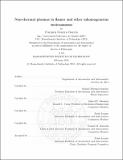| dc.contributor.advisor | Manuel Martinez-Sanchez. | en_US |
| dc.contributor.author | Guerra García, Carmen | en_US |
| dc.contributor.other | Massachusetts Institute of Technology. Department of Aeronautics and Astronautics. | en_US |
| dc.date.accessioned | 2015-06-10T18:40:52Z | |
| dc.date.available | 2015-06-10T18:40:52Z | |
| dc.date.copyright | 2015 | en_US |
| dc.date.issued | 2015 | en_US |
| dc.identifier.uri | http://hdl.handle.net/1721.1/97262 | |
| dc.description | Thesis: Ph. D., Massachusetts Institute of Technology, Department of Aeronautics and Astronautics, 2015. | en_US |
| dc.description | This electronic version was submitted by the student author. The certified thesis is available in the Institute Archives and Special Collections. | en_US |
| dc.description | Cataloged from Student-submitted PDF version of thesis. | en_US |
| dc.description | Includes bibliographical references (pages 227-244). | en_US |
| dc.description.abstract | Non-thermal plasmas in non-uniform gases appear in several technological applications (plasma assisted combustion and aerodynamics, and plasma jets), as well as in natural phenomena (sprites). Whereas in the case of plasma jets and sprites this problem has captured significant attention, the implications of an inhomogeneous background gas in the other fields need to be further explored. In particular, non-thermal plasmas used to assist or stabilize flames are subject to gradients in temperature, composition and pre-ionization, which impact the electrical breakdown characteristics and the energy coupling to the flame and its flow field. In this dissertation, the impact of such inhomogeneities in the breakdown modes of repetitive pulsed nanosecond discharges, one of the main strategies used for plasma creation in the field of plasma assisted combustion, is explored. First, a simplified non-reacting platform is proposed that consists on a sandwich-like structure of gases with different ionization properties, due to differences in composition or temperature. In this configuration, selective breakdown of a region of favorable ionization was experimentally observed, even when this region was not in contact with the electrodes. A numerical model was used to explain the dynamics of streamers at the interface of two distinct gases, within the layered gas configuration. Many similarities with traditional dielectric barrier discharges are revealed, where the role of the solid dielectric is played by the more insulating gas. The experiments were then extended to a counterflow nonpremixed flame environment for which selective excitation of the flame was also observed. Such a strategy ensures that the plasma-created radicals and short-lived species participate in the combustion reactions, but it is achieved at the expense of a limited energy deposition. Finally, a discussion of experimental observations using AC voltage in the kHz range on the counterflow nonpremixed flame, highlights the role of the finite size of the pre-ionization zone on the conversion of the electrical energy into kinetic energy of the flow (ionic winds). | en_US |
| dc.description.statementofresponsibility | by Carmen Guerra García. | en_US |
| dc.format.extent | 244 pages | en_US |
| dc.language.iso | eng | en_US |
| dc.publisher | Massachusetts Institute of Technology | en_US |
| dc.rights | M.I.T. theses are protected by copyright. They may be viewed from this source for any purpose, but reproduction or distribution in any format is prohibited without written permission. See provided URL for inquiries about permission. | en_US |
| dc.rights.uri | http://dspace.mit.edu/handle/1721.1/7582 | en_US |
| dc.subject | Aeronautics and Astronautics. | en_US |
| dc.title | Non-thermal plasmas in flames and other inhomogeneous environments | en_US |
| dc.type | Thesis | en_US |
| dc.description.degree | Ph. D. | en_US |
| dc.contributor.department | Massachusetts Institute of Technology. Department of Aeronautics and Astronautics | |
| dc.identifier.oclc | 910627468 | en_US |
